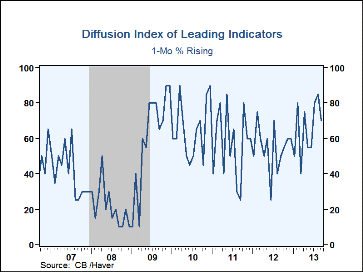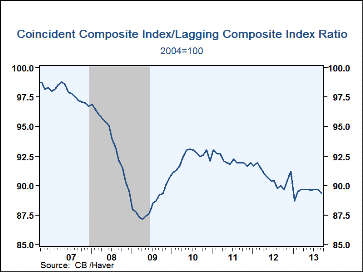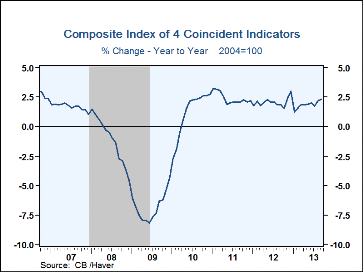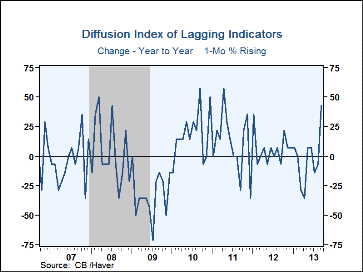 Global| Nov 06 2013
Global| Nov 06 2013U.S. Leading Economic Indicators Post Another Firm Increase
by:Tom Moeller
|in:Economy in Brief
Summary
The index of Leading Economic Indicators, published by the Conference Board, again rose 0.7% during September (4.2% y/y). That remained the strongest since April. A 0.6% rise had been expected in the Action Economics Forecast Survey. [...]
The index of Leading Economic Indicators, published by the Conference Board, again rose 0.7% during September (4.2% y/y). That remained the strongest since April. A 0.6% rise had been expected in the Action Economics Forecast Survey. The breadth of component increase slipped m/m to a still-broad 70%. Fewer initial unemployment insurance claims, a steeper interest rate yield curve, the ISM new orders index and the leading credit index had the largest positive influences on the total. These were followed by higher consumer goods & materials orders, higher stock prices and more building permits.
Another leading economic series is the ratio of coincident-to-lagging indicators. It measures how the economy is performing versus its excesses. The figure fell last month (-0.7% y/y) and has been moving sideways all year.
The index of coincident indicators rose 0.2% (2.3% y/y) after a 0.3% August gain. Each of the component series - payroll employment, personal income less transfers, manufacturing & trade sales and industrial production - increased.
The index of lagging economic indicators rose 0.6% (3.0% y/y) following an unrevised 0.3% August increase. More commercial & industrial loans outstanding continued to have the greatest positive effect on the index. That was followed by a higher consumer installment credit/income ratio and a strengthened gain in the services CPI.
The Conference Board figures are available in Haver's BCI database; the components are available there, and most are also in USECON. The forecast figures for the Consensus are in the AS1REPNA database. Visit the Conference Board's site for coverage of leading indicator series from around the world.
| Business Cycle Indicators (%) | Sep | Aug | Jul | Y/Y | 2012 | 2011 | 2010 |
|---|---|---|---|---|---|---|---|
| Leading | 0.7 | 0.7 | 0.4 | 4.2 | 2.0 | 5.1 | 8.0 |
| Coincident | 0.2 | 0.3 | 0.0 | 2.3 | 2.1 | 2.4 | 1.2 |
| Lagging | 0.6 | 0.3 | -0.1 | 3.0 | 3.6 | 2.7 | -3.1 |
Tom Moeller
AuthorMore in Author Profile »Prior to joining Haver Analytics in 2000, Mr. Moeller worked as the Economist at Chancellor Capital Management from 1985 to 1999. There, he developed comprehensive economic forecasts and interpreted economic data for equity and fixed income portfolio managers. Also at Chancellor, Mr. Moeller worked as an equity analyst and was responsible for researching and rating companies in the economically sensitive automobile and housing industries for investment in Chancellor’s equity portfolio. Prior to joining Chancellor, Mr. Moeller was an Economist at Citibank from 1979 to 1984. He also analyzed pricing behavior in the metals industry for the Council on Wage and Price Stability in Washington, D.C. In 1999, Mr. Moeller received the award for most accurate forecast from the Forecasters' Club of New York. From 1990 to 1992 he was President of the New York Association for Business Economists. Mr. Moeller earned an M.B.A. in Finance from Fordham University, where he graduated in 1987. He holds a Bachelor of Arts in Economics from George Washington University.










